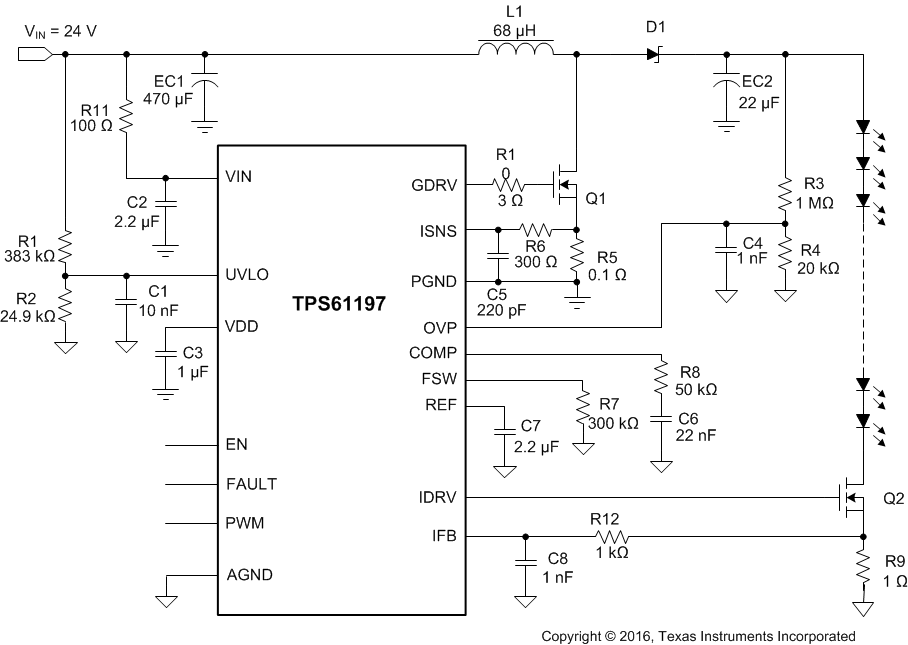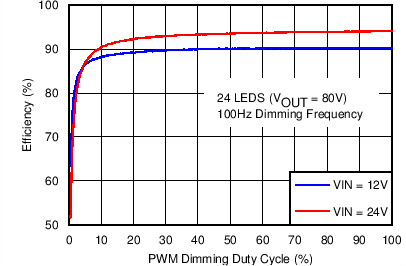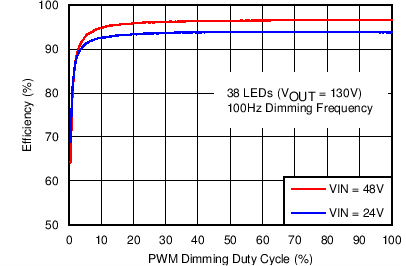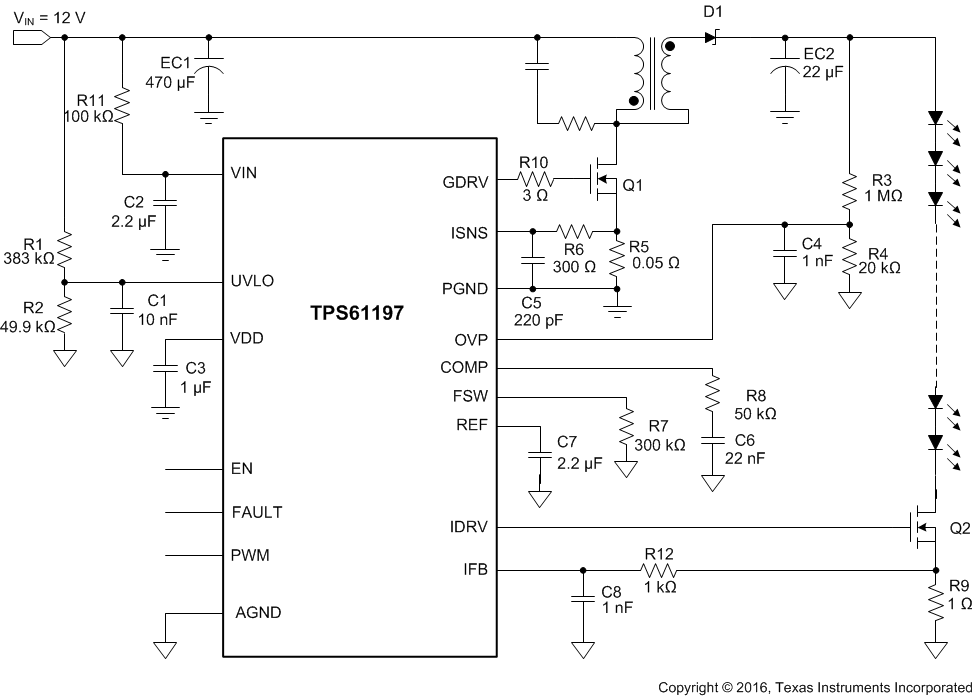SLVSC25B July 2013 – June 2017 TPS61197
PRODUCTION DATA.
- 1 Features
- 2 Applications
- 3 Description
- 4 Revision History
- 5 Pin Configuration and Functions
- 6 Specifications
-
7 Detailed Description
- 7.1 Overview
- 7.2 Functional Block Diagram
- 7.3 Feature Description
- 7.4
Device Functional Modes
- 7.4.1
Protections
- 7.4.1.1 Switch Current Limit Protection Using the ISNS Pin
- 7.4.1.2 LED Open Protection
- 7.4.1.3 Schottky Diode Open Protection
- 7.4.1.4 Schottky Diode Short Protection
- 7.4.1.5 IFB Overvoltage Protection
- 7.4.1.6 Output Overvoltage Protection Using the OVP Pin
- 7.4.1.7 IFB Short-to-Ground Protection
- 7.4.1.8 Thermal Shutdown
- 7.4.1
Protections
- 8 Application and Implementation
- 9 Power Supply Recommendations
- 10Layout
- 11Device and Documentation Support
- 12Mechanical, Packaging, and Orderable Information
Package Options
Mechanical Data (Package|Pins)
- D|16
Thermal pad, mechanical data (Package|Pins)
Orderable Information
8 Application and Implementation
NOTE
Information in the following applications sections is not part of the TI component specification, and TI does not warrant its accuracy or completeness. TI’s customers are responsible for determining suitability of components for their purposes. Customers should validate and test their design implementation to confirm system functionality.
8.1 Application Information
The TPS61197 is designed for LCD TV backlighting. It is a current-mode boost controller driving one white-LED string with multiple LEDs in series. The input voltage range for the device is from 8 V to 30 V. Its switching frequency is programmed by an external resistor from 50 kHz to 800 kHz.
The TPS61197 has a built-in linear regulator, which steps down the input voltage to the VDD voltage for powering the internal circuitry. An internal soft start circuit is implemented to work with an external capacitor to adjust the soft start-up time to minimize the in-rush current during boost converter start-up.
8.2 Typical Applications
8.2.1 Simple Boost Converter
The TPS61197 is configured as a simple boost converter to drive the single string with the LEDs when the boost ratio of the output voltage to the input voltage is less than 6.
 Figure 18. TPS61197 Simple Boost-Converter Application
Figure 18. TPS61197 Simple Boost-Converter Application
8.2.1.1 Design Requirements
For LED-driver applications, use the parameters listed in Table 4.
Table 4. Design Parameters
| DESIGN PARAMETER | EXAMPLE VALUE |
|---|---|
| Input voltage | 8 V to 30 V |
| Output voltage | VIN to 300 V |
| Output current | 300 mA (maximum) |
| Programmable switching frequency | 50 kHz to 800 kHz |
8.2.1.2 Detailed Design Procedure
8.2.1.2.1 Inductor Selection
The inductor is the most important component in switching power regulator design because it affects power supply steady state operation, transient behavior, and loop stability. The inductor value, DC resistance and saturation current are important specifications to be considered for better performance. Although the boost power stage can be designed to operate in discontinuous conduction mode (DCM) at maximum load, where the inductor current ramps down to zero during each switching cycle, most applications are more efficient if the power stage operates in continuous conduction mode (CCM), where a DC current flows through the inductor. Therefore, the Equation 7 and Equation 8 are for CCM operation only. The TPS61197 device is designed to work with inductor values from 4.7 µH and 470 µH, depending on the switching frequency. Running the controller at higher switching frequencies allows the use of smaller and/or lower profile inductors in the 4.7-µH range. Running the controller at slower switching frequencies requires the use of larger inductors, near 470 µH, to maintain the same inductor current ripple but may improve overall efficiency due to smaller switching losses. Inductor values can have ±20% tolerance with no current bias. When the inductor current approaches saturation level, its inductance can decrease 20% to 35% from the value measured at near 0 A, depending on how the inductor vendor defines saturation.
In a boost regulator, the inductor DC current can be calculated with Equation 6.

where
- VOUT = boost output voltage
- IOUT = boost output current
- VIN = boost input voltage
- η = power conversion efficiency, use 95% for TPS61197 applications
The inductor peak-to-peak ripple current can be calculated with Equation 7.

where
- ΔIL(P-P) = inductor ripple current
- L = inductor value
- fSW = switching frequency
- VOUT = boost output voltage
- VIN = boost input voltage
Therefore, the inductor peak current is calculated with Equation 8.

Select an inductor, which saturation current is higher than calculated peak current. To calculate the worst case inductor peak current, use the minimum input voltage, maximum output voltage and maximum load current.
Regulator efficiency is dependent on the resistance of its high current path and switching losses associated with the switch FET and power diode. Besides the external switch FET, the overall efficiency is also affected by the inductor DC resistance (DCR). Usually the lower DC resistance shows higher efficiency. However, there is a tradeoff between DCR and inductor footprint; furthermore, shielded inductors typically have higher DCR than unshielded ones.
8.2.1.2.2 Output Capacitor
The output capacitor is mainly selected to meet the requirements for output ripple and loop stability of the whole system. This ripple voltage is related to the capacitance of the capacitor and its equivalent series resistance (ESR). Assuming a capacitor with zero ESR, the minimum capacitance needed for a given ripple can be calculated by:

where
- VRIPPLE is the peak-to-peak output voltage ripple
- DMAX is the maximum duty cycle of the boost converter in the application
DMAX is approximately equal to (VOUT(MAX) – VIN(MIN) / VOUT(MAX)) in applications. Care must be taken when evaluating a capacitor’s derating under DC voltage. The DC bias voltage can also significantly reduce capacitance. Ceramic capacitors can loss as much as 50% of its capacitance at its rated voltage. Therefore, leave the margin on the voltage rating to ensure adequate capacitance.
The ESR impact on the output ripple must be considered as well if tantalum or aluminum electrolytic capacitors are used. Assuming there is enough capacitance such that the ripple due to the capacitance can be ignored, the ESR needed to limit the VRIPPLE is:

Ripple current flowing through a capacitor’s ESR causes power dissipation in the capacitor. This power dissipation causes temperature increase internally to the capacitor. Excessive temperature can seriously shorten the expected life of a capacitor. Capacitors have ripple current ratings that are dependent on ambient temperature and must not be exceeded. Therefore, high ripple current type electrolytic capacitor with small ESR is used in the typical application as shown in Figure 18.
In the typical application, the output requires a capacitor in the range of 1 µF to 100 µF. The output capacitor affects the small signal control loop stability of the boost converter. If the output capacitor is below the range, the boost regulator may potentially become unstable.
8.2.1.2.3 Schottky Diode
The TPS61197 demands a high-speed rectification for optimum efficiency. Ensure that the average and peak current rating of the diode exceed the output LED current and inductor peak current. In addition, the reverse breakdown voltage of the diode must exceed the application output voltage.
8.2.1.2.4 Switch MOSFET and Gate Driver Resistor
The TPS61197 demands a power N-MOSFET (see Q1 in Figure 18) as a switch. The voltage and current rating of the MOSFET must be higher than the application output voltage and the inductor peak current. The applications benefit from the addition of a resistor (see R10 in Figure 18) connected between the GDRV pin and the gate of the switch MOSFET. With this resistor, the gate driving current is limited and the EMI performance is improved. TI recommends 3-Ω resistor value. The TPS61197 exhibits lower efficiency when the resistor value is above 3 Ω due to the more switching loss of the external MOSFET.
8.2.1.2.5 Current Sense and Current Sense Filtering
R5 determines the correct overcurrent limit protection. To choose the right value of R5, start with the total system power needed POUT, and calculate the input current IIN by Equation 6. Efficiency can be estimated from Figure 20. The second step is to calculate the inductor peak current based on the inductor value L using Equation 7 and Equation 8. The maximum R5 can now be calculated as R5(maximum) = VISNS_OC / IL(P). TI recommends adding 20% or more margins to account for component variations. A small filter placed on the ISNS pin improves performance of the converter (see R6 and C5 in Figure 18). The time constant of this filter must be approximately 100 ns. The range of R6 must be from about 300 Ω to 1 kΩ for best results. Locate C5 as close as possible to the ISNS pin to provide noise immunity.
8.2.1.2.6 Loop Consideration
The COMP pin on the TPS61197 is used for external compensation, allowing the loop response to be optimized for each application. The COMP pin is the output of the internal trans-conductance amplifier. The external resistor R8, along with ceramic capacitors C6 (see Figure 18), are connected to the COMP pin to provide poles and zero. The pole and zero, along with the inherent pole and zero in a peak current mode control boost converter, determine the closed loop frequency response. This is important to converter stability and transient response.
The first step is to calculate the pole and the right half plane zero of the peak current mode boost converter by Equation 11 and Equation 12.


To make the loop stable, the loop must have sufficient phase margin at the crossover frequency where the loop gain is 1. To avoid the effect of the right half plane zero on the loop stability, choose the crossover frequency fCO less than 1/5 of the fZRHP. Then calculate the compensation components by Equation 13 and Equation 14.

where
- VOVPTH = 3.04 V, which is the overvoltage protection threshold at the OVP pin
- VOUT_OVP is the setting output over-voltage protection threshold
- GmEA is the trans-conductance of the error amplifier (the typical value of the GmEA is 120 μs)
- fCO is the crossover frequency, which normally is less than 1/5 of the fZRHP
If the output capacitor is the electrolytic capacitor which may have large ESR, a capacitor is required at the COMP pin or at the OVP pin to cancel the inherent zero of the output capacitor.
8.2.1.3 Application Curves


8.2.2 PWM Dimming Controlled by Boost Converter
The TPS61197 also supports the PWM dimming by turning on and off the boost converter to save cost of the dimming MOSFET. Figure 21 is the application circuit. This application requires small output capacitance so as to discharge the output voltage fast during dimming off period. The minimum dimming on time must be longer than 200 µs to ramp up the output voltage to achieve the setting LED current during dimming on period.
 Figure 21. PWM Dimming By Turning On and Off the Boost Converter
Figure 21. PWM Dimming By Turning On and Off the Boost Converter
8.2.3 High Boost Ratio Application
When the boost ratio is higher than 6, a transformer is required to replace the inductor to make the switching duty cycle near 50% and lower the voltage rating of the switch FET. Figure 22 is the application circuit.
 Figure 22. TPS61197 High Boost Ratio Application
Figure 22. TPS61197 High Boost Ratio Application
